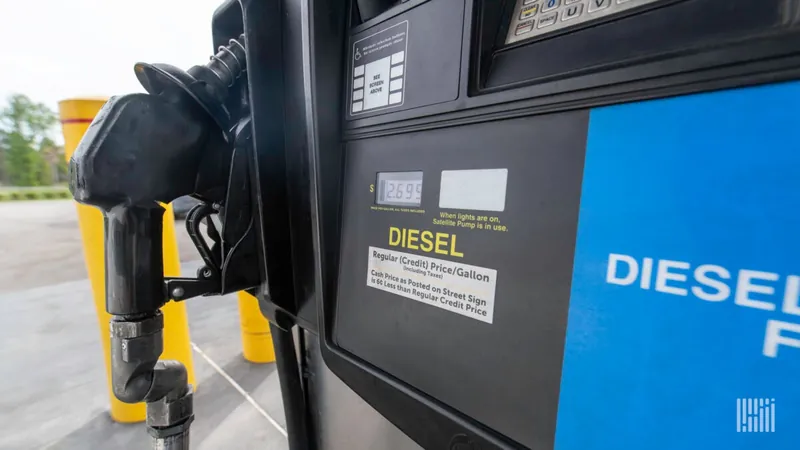
The Oil Market of 2025: Shifts Indicate Opportunities for Buyers
2024-12-30
Author: Emily
Overview of the Oil Market in 2025
As we look ahead to 2025, the outlook for consumers in the oil market is increasingly favorable, according to the latest projections from the International Energy Agency (IEA). The IEA's final monthly report reveals key insights into the anticipated dynamics of supply and demand that could favor buyers.
Demand and Supply Projections
Demand for oil is expected to grow by approximately 1.1 million barrels per day compared to 2024, bringing total consumption to an average of 103.9 million barrels per day for 2025. On the other hand, supply projections are even more promising: the IEA estimates that total petroleum supply—encompassing crude oil, natural gas liquids, and biofuels—will rise by 1.9 million barrels per day, reaching an average of 104.8 million barrels daily. This forecast suggests that supply will outstrip demand by about one million barrels per day, positioning consumers to benefit from potential price declines.
OPEC+ Production Cuts
However, this scenario hinges on the OPEC+ coalition, which includes both OPEC members and several non-OPEC countries led by Russia, maintaining their production cuts of 2.2 million barrels per day. Despite plans for a gradual rollback of these cuts starting in April, the persistent oversupply could compel OPEC+ to reconsider its strategy to stabilize prices.
Influence of U.S. Oil Production
A significant factor contributing to the price pressure is the surge in U.S. oil production, currently peaking at about 13.6 million barrels per day according to the Energy Information Administration (EIA). Additionally, new contributions from nations like Guyana are further bolstering global oil supply.
Impact of Electric Vehicles on Demand
Another major player creating market ripples is the rising popularity of electric vehicles (EVs) globally, which continues to reshape the demand landscape. A recent Argus Media report highlighted that, despite reports of flat EV sales in the United States, countries like China are witnessing explosive growth in electric vehicle adoption. The implications of this transition are proving detrimental to the traditional diesel market.
Trends in Diesel Consumption
European diesel consumption is witnessing a significant and chronic decline fueled by government policies promoting low-emission zones. Consumers are pivoting toward gasoline and alternative fuel vehicles, leading to a marked drop in diesel's market share—declines of 5% in Germany and over 10% in France have been noted since 2017.
Fluctuations in Asian Diesel Demand
Interestingly, even as the European market sees a drop in diesel demand, Asia's appetite for diesel has fluctuated. Notably, in China, diesel demand experienced a sudden dip in 2024, coinciding with a slowdown in construction activities and a notable shift towards electric vehicles.
Shifting Automotive Landscape in China
Jim Burkhard, Vice President at SPGCI, emphasized the staggering shift in the Chinese automotive landscape, reporting that half of the new car sales in the country are now electric. This paradigm shift indicates an overarching trend where petroleum demand, particularly for gasoline and diesel, may have already peaked in the world's most populous nation.
Growth in Petrochemical Demand
However, not all sectors are facing decline. The demand for petroleum used in petrochemicals continues to grow, suggesting that although transportation fuels face constraints due to evolving consumer behaviors and technological advancements, the broader petroleum market remains diverse and resilient.
Conclusion and Future Outlook
As we gear up for 2025, analysts predict that the dynamics of the oil market could spell significant opportunities for buyers, particularly as structural shifts in consumer preferences and production strategies unfold on a global scale. Stay alert, as these changes could revolutionize the landscape of energy consumption!









 Brasil (PT)
Brasil (PT)
 Canada (EN)
Canada (EN)
 Chile (ES)
Chile (ES)
 Česko (CS)
Česko (CS)
 대한민국 (KO)
대한민국 (KO)
 España (ES)
España (ES)
 France (FR)
France (FR)
 Hong Kong (EN)
Hong Kong (EN)
 Italia (IT)
Italia (IT)
 日本 (JA)
日本 (JA)
 Magyarország (HU)
Magyarország (HU)
 Norge (NO)
Norge (NO)
 Polska (PL)
Polska (PL)
 Schweiz (DE)
Schweiz (DE)
 Singapore (EN)
Singapore (EN)
 Sverige (SV)
Sverige (SV)
 Suomi (FI)
Suomi (FI)
 Türkiye (TR)
Türkiye (TR)
 الإمارات العربية المتحدة (AR)
الإمارات العربية المتحدة (AR)